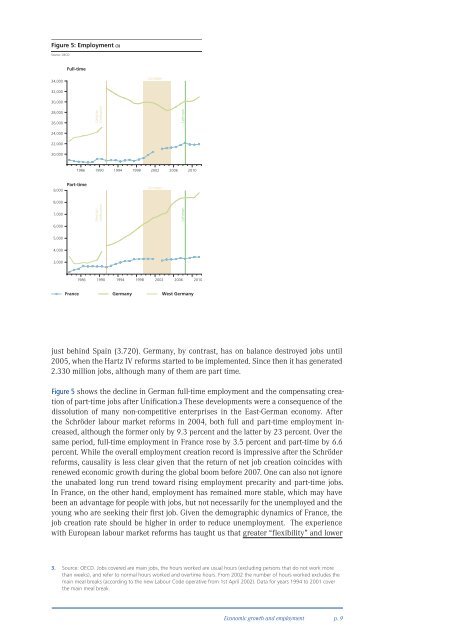A-Franco-German-Tale
A-Franco-German-Tale
A-Franco-German-Tale
- No tags were found...
You also want an ePaper? Increase the reach of your titles
YUMPU automatically turns print PDFs into web optimized ePapers that Google loves.
Figure 5: Employment (3)Source: OECDFull-time34,000Schröder32,00030,00028,00026,000<strong>German</strong>UnificationLehman24,00022,00020,0001986 1990 1994 1998 2002 2006 20109,000Part-timeSchröder8,0007,000<strong>German</strong>UnificationLehman6,0005,0004,0003,0001986 1990 1994 1998 2002 2006 2010France <strong>German</strong>y West <strong>German</strong>yjust behind Spain (3.720). <strong>German</strong>y, by contrast, has on balance destroyed jobs until2005, when the Hartz IV reforms started to be implemented. Since then it has generated2.330 million jobs, although many of them are part time.Figure 5 shows the decline in <strong>German</strong> full-time employment and the compensating creationof part-time jobs after Unification.3 These developments were a consequence of thedissolution of many non-competitive enterprises in the East-<strong>German</strong> economy. Afterthe Schröder labour market reforms in 2004, both full and part-time employment increased,although the former only by 9.3 percent and the latter by 23 percent. Over thesame period, full-time employment in France rose by 3.5 percent and part-time by 6.6percent. While the overall employment creation record is impressive after the Schröderreforms, causality is less clear given that the return of net job creation coincides withrenewed economic growth during the global boom before 2007. One can also not ignorethe unabated long run trend toward rising employment precarity and part-time jobs.In France, on the other hand, employment has remained more stable, which may havebeen an advantage for people with jobs, but not necessarily for the unemployed and theyoung who are seeking their first job. Given the demographic dynamics of France, thejob creation rate should be higher in order to reduce unemployment. The experiencewith European labour market reforms has taught us that greater “flexibility” and lower3. Source: OECD. Jobs covered are main jobs, the hours worked are usual hours (excluding persons that do not work morethan weeks), and refer to normal hours worked and overtime hours. From 2002 the number of hours worked excludes themain meal breaks (according to the new Labour Code operative from 1st April 2002). Data for years 1994 to 2001 coverthe main meal break.Economic growth and employmentp. 9



